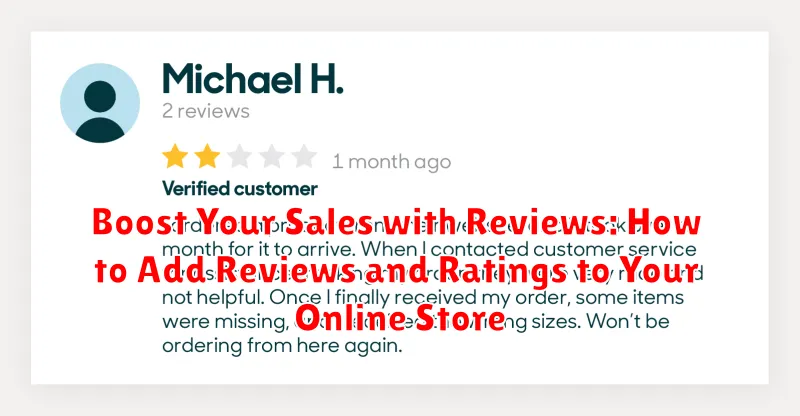In today’s competitive e-commerce landscape, reviews and ratings play a pivotal role in influencing purchasing decisions. Potential customers rely heavily on the experiences of others before committing to a purchase. Therefore, integrating a robust review system into your online store is no longer just a nice-to-have, it’s a necessity. This article will guide you through the process of adding reviews and ratings to your online store, ultimately helping you boost sales and build customer trust.
Learn how to leverage the power of social proof by incorporating reviews and ratings effectively. We’ll cover various methods for integrating these essential features, regardless of your platform or technical expertise. Discover how to encourage customer feedback, manage reviews, and ultimately use this valuable information to enhance your products, optimize your website, and boost sales. This comprehensive guide will provide you with the tools and knowledge necessary to harness the full potential of reviews and ratings for your online store.
The Importance of Customer Reviews and Ratings
In today’s digital marketplace, customer reviews and ratings hold immense power. They act as social proof, influencing purchasing decisions and shaping brand perception. Potential customers often rely heavily on the experiences of others before committing to a purchase.
Positive reviews build trust and credibility. A high average rating can significantly increase the likelihood of a customer choosing your product over a competitor’s. They showcase the value and quality of your offerings through authentic customer experiences.
Furthermore, reviews provide valuable feedback. They can highlight areas where your products or services excel and identify areas needing improvement. This feedback loop allows you to continuously refine your offerings and enhance customer satisfaction.
Choosing the Right Review Platform for Your Store
Selecting the right review platform is crucial for maximizing the impact of customer feedback. Consider these factors when making your decision:
Pricing: Platforms range from free to premium, with varying features at each level. Carefully evaluate your budget and the features offered to determine the best value.
Ease of Integration: A seamless integration with your existing e-commerce platform is essential. Look for platforms that offer plugins or APIs specifically designed for your platform.
Customization Options: The ability to customize the look and feel of reviews to match your branding can enhance the overall user experience.
Moderation Features: Effective moderation tools help you manage reviews, filter spam, and address inappropriate content.
Analytics and Reporting: Robust reporting features provide valuable insights into customer sentiment, product performance, and the overall effectiveness of your review strategy.
Integrating Reviews with Your E-commerce Platform
Seamless integration of your chosen review platform with your e-commerce platform is crucial for a smooth customer experience. Most popular review platforms offer dedicated integrations or plugins for major e-commerce platforms like Shopify, WooCommerce, and BigCommerce.
Typically, integration involves installing a plugin or adding a code snippet to your store’s theme. This connection allows reviews to be displayed directly on your product pages, often below the product description or near the “add to cart” button. This placement ensures that reviews are readily visible to potential buyers, influencing their purchase decisions.
Ensure the integration is compatible with your specific e-commerce platform and theme version. Check for updates regularly to maintain optimal functionality and security. Some platforms may offer built-in review features. Consider their capabilities before opting for a third-party solution.
Once integrated, test the display thoroughly. Verify reviews appear correctly on various devices (desktops, tablets, mobiles). Check for responsiveness and correct styling. A seamless integration enhances the overall shopping experience and strengthens customer trust.
Encouraging Customers to Leave Reviews

Proactively seeking reviews is crucial for building a strong online reputation. Directly asking satisfied customers is one of the most effective methods. A simple email or SMS message shortly after a purchase can significantly increase review submission rates. Personalize the message and make the process as easy as possible.
Incentivizing reviews can also be a powerful motivator. Offer small rewards, such as discounts on future purchases or entry into a prize draw, for leaving a review. Clearly communicate the terms of the incentive program to maintain transparency and avoid any perception of manipulation.
Make leaving reviews convenient. Provide clear instructions and direct links to your review platform. Consider using QR codes on packaging or receipts for easy access via mobile devices. Minimize the steps required to submit a review, as lengthy forms can deter customers.
Follow up with customers. If a customer expresses satisfaction with their purchase, gently remind them to share their experience by leaving a review. This reinforces the importance of their feedback and demonstrates your commitment to customer satisfaction.
Managing Negative Reviews
Negative reviews are inevitable. Instead of fearing them, view them as opportunities for improvement and to build trust. Do not delete negative reviews unless they violate your platform’s terms of service (e.g., containing profanity, hate speech, or personal attacks).
Respond promptly and professionally to all negative reviews. Acknowledge the customer’s experience and apologize for any inconvenience. Offer a solution or course of action to rectify the situation. This demonstrates that you value customer feedback and are committed to providing excellent service.
Take the conversation offline. Provide a customer service email address or phone number so you can address the specific issue privately. This shows other potential customers that you take concerns seriously and are willing to work towards a resolution.
Learn from negative feedback. Analyze recurring complaints to identify areas where you can improve your products, services, or processes. Negative reviews can be valuable sources of information for enhancing your business.
Displaying Reviews Effectively on Your Website

Strategic placement of reviews significantly impacts their effectiveness. Showcase reviews prominently on your product pages, placing them near the “add to cart” button. This allows customers to see positive feedback just before making a purchase decision.
Consider incorporating a dedicated reviews tab or section on product pages for easy access to all customer feedback. This organized approach facilitates browsing and comparison of different opinions.
Highlight key excerpts from positive reviews on your homepage or category pages to capture attention and build trust. Short, impactful snippets can entice potential buyers to explore further.
Implement a star rating system for quick visual representation of overall product satisfaction. This provides an at-a-glance summary and aids in filtering and sorting products based on customer ratings.
Use a consistent format for displaying reviews to maintain a clean and professional look. Ensure readability with clear fonts, sufficient spacing, and a user-friendly layout.
Using Reviews to Improve Your Products and Services
Customer reviews are more than just testimonials; they’re a valuable source of feedback for product development and service improvement. Analyzing reviews can reveal hidden strengths and weaknesses that might be missed through internal assessments.
Identify Areas for Improvement: Negative reviews often pinpoint specific problems with your products or services. Pay close attention to recurring complaints, as these highlight areas needing immediate attention. Whether it’s slow shipping, confusing product descriptions, or a faulty design element, addressing these issues directly leads to enhanced customer satisfaction.
Recognize What You’re Doing Right: Positive reviews highlight what resonates with customers. Identify common themes in positive feedback to understand which features or aspects of your service are most appreciated. This knowledge can be used to inform future product development and marketing strategies.
Track Progress Over Time: Regularly monitoring reviews allows you to track the impact of changes you implement. See if addressing specific issues results in fewer negative reviews and an increase in positive sentiment. This provides measurable data to demonstrate the effectiveness of your efforts.
Best Practices for Reviews and Ratings
Authenticity is paramount. Never fabricate reviews or incentivize positive feedback dishonestly. Encourage genuine reviews from actual customers. Transparency builds trust.
Respond to reviews, both positive and negative. Thanking customers for positive reviews shows appreciation. Addressing negative reviews publicly demonstrates a commitment to customer satisfaction and provides an opportunity to rectify issues.
Moderate reviews fairly. While you should remove spam or inappropriate content, avoid deleting negative reviews solely because they are critical. Establish clear guidelines for review moderation and apply them consistently.
Display reviews prominently. Don’t bury reviews deep within your website. Feature them on product pages, the homepage, and other key areas to maximize visibility.
Keep reviews fresh. Regularly solicit new reviews to ensure your content remains relevant and reflects current customer experiences.

